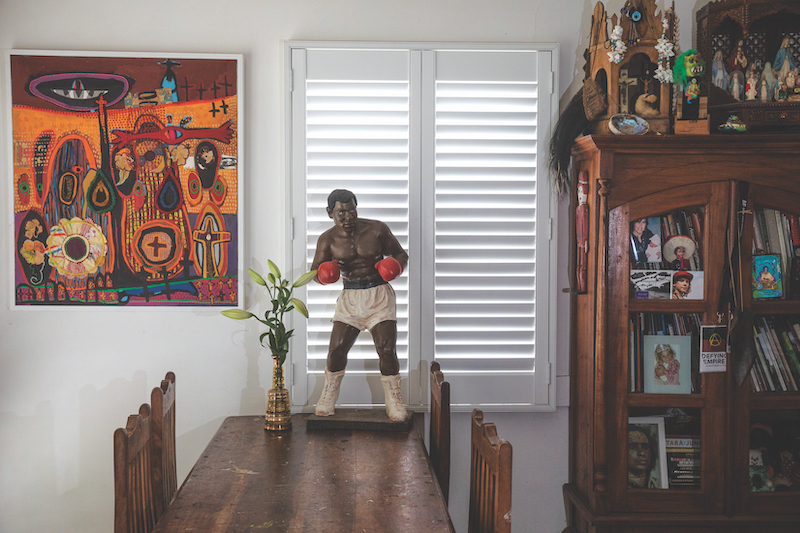Perched on a ridge in Bundjalung Country in northern New South Wales, the 1960s era home of Wiradjuri artist Karla Dickens has huge windows that take in sweeping views of spectacular sunsets. “I always see the windows as framed moving art changing at different times of the day,” says Dickens. A leafy garden peppered with statues and rusty carnival flotsam can also be seen through the windows and at night, great sheets of stars are sprinkled overhead.
Describing her home as “solid, funky, and practical,” Dickens has transformed her living space into a comforting base fit for rejuvenation and inspiration. “When I’m working, the house feels like a circuit I meander around, with doors leading to gardens as random in plant choices as the odd bits and pieces inside.” Much like the art she creates, Dickens’ interiors are filled with meticulously crafted collections of objects and images sourced from her travels and personal experiences. “Stories are many and varied throughout my home. Most are random personal stories of place, memories and moments. I love creating relationships with objects that tell a larger story, even if it’s simply about my love of green and red or growing up in South Sydney Rabbitohs Country.”
For an artist whose work frequently centres on themes of systemic racism, transgenerational trauma and the environment, Dickens’ home is her personal sanctuary. Important anchor points are the visually striking altars she has built up over time. Comprised of eclectic groupings of crucifixes, Virgin Mary statues, family photos and knick-knacks, the altars function as beacons of strength and protection throughout the house. “I didn’t feel safe as a child and teenager, so I started to collect things that might protect me,” Dickens explains. “The foyer to my house has a large altar at the centre with shell necklaces, religious iconography and countless random talisman trinkets.” Partly inspired by the makeshift shrines she would regularly come across while attending residencies in Indonesia, Dickens’ altars embrace multiple faiths.
“I’ve been going to Indonesia since I was 18 so there are objects from many denominations – Hindu, Buddhist, Christian. Anything I feel is a symbol of protection is there in these altars.”
Much of the interior wall space is covered with standout pieces from Dickens’ celebrated art career, which began in 1993. Near an internal doorway is one of 20 pieces created for her 2017 Warrior Women series. Made from a silver coated pair of boyleg undies, threaded into the surface are strips of rusty metal, hair and wire – materials Dickens frequently uses in her artwork. “It’s been a practical solution to hang my own work in my home as storage is difficult. It’s also about preserving a personal collection of my work for my daughter Ginger and our future.” Travelling further through her home reveals even more shelves and surfaces covered with diminutive yet immensely meaningful objects. “In my kitchen there are retro Australian tins, Aboriginal plates, 1960s glass and vintage jars, while the lounge room mantle holds a solid collection of Aboriginal artefacts, handmade wooden carvings from around the world and the odd pirate.”
Sharing the space with her daughter and family dog Kharlee, Dickens’ home also includes a studio where she works and stores her materials. Filled with drawers and overflowing boxes of items like mismatched swatches of fabric, souvenir spoons and dried bones, it is a place she visits daily. As a mother to a teenager, having her studio at home is deeply important and allows for the multi-tasking parenting inevitably involves. “Some artists might not like having a studio at home but as a mother, I appreciate that my studio is close to the house.” Outside, dedicated spaces in the garden contain objects destined for future artwork. “I have my A grade rust protected outside. I have areas for different collections across a quarter of an acre. I try to separate my studio from the house but anything and everything is up for an artwork.”
Featured image: in the dining room hangs Dickens’ 2007 work Landed. Photo: Natalie Grono. Courtesy: Karla Dickens.

